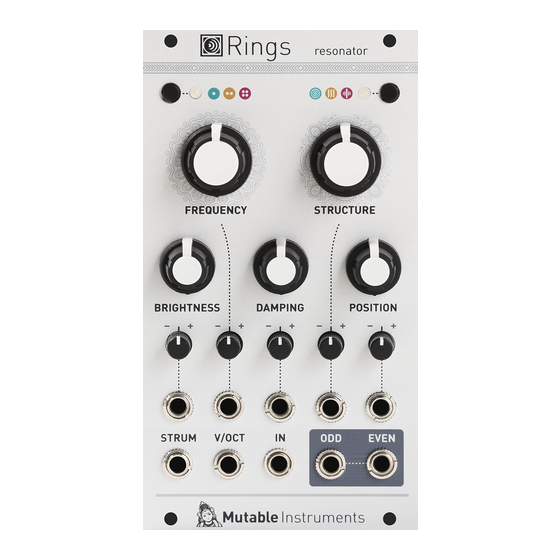
Table of Contents
Advertisement
Quick Links
5/3/2018
Rings
OVERVIEW
Rings is a resonator, the essential ingredient at the core of several physical modelling techniques. It
transforms an external, unpitched excitation audio signal (such as a click, a burst of noise, or whatever is
captured by a contact microphone) into a full-bodied pitched sound. Rings is the bar, the tube or the bunch
of strings you cause to vibrate with an external signal.
INSTALLATION
Rings is designed for Eurorack synthesizer systems and occupies 14 HP of space. It requires a -12V /
+12V supply (2x5 pin connector), drawing 5mA from the -12V rail and 120mA from the +12V rail. The red
stripe of the ribbon cable must be oriented on the same side as the "Red stripe" marking on the printed
circuit board.
This device complies with part 15 of the FCC Rules. Operation is subject to the following
two conditions: (1) This device may not cause harmful interference, and (2) this device must
accept any interference received, including interference that may cause undesired
operation.
This device meets the requirements of the following standards: EN55032, EN55103-2,
EN61000-3-2, EN61000-3-3, EN62311.
RINGS' BASICS
Polyphony and synthesis method
How the module operates is governed by two settings controlled by buttons at the top of the module. Once
these are set, no hidden mysteries! $
Polyphony selection
The first button selects the polyphony of the module: one, two, or four notes. Enabling four notes
polyphony doesn't mean that four CV input jacks will magically appear on the module, but simply that four
notes played in sequence will nicely overlap without cutting each other's tails. To play chords, you will
need to "strum" the module by playing a rapid sequence of notes - something you might have already
encountered with Braids'
generated signals to cope with the higher polyphony.
The second button selects the three available types of resonators. They are:
Modal resonator
Modal synthesis works by simulating the phenomena of resonance at play in vibrating structures, that is to
say the way a string or plate (for instance) will absorb certain frequencies while it will "ring" at some other
https://mutable-instruments.net/modules/rings/manual/
User manual
PLUK
model. Note that the module might reduce the number of harmonics in the
Mutable Instruments | Rings
1/4
Advertisement
Table of Contents

Summary of Contents for Mutable Instruments Rings
- Page 1 (such as a click, a burst of noise, or whatever is captured by a contact microphone) into a full-bodied pitched sound. Rings is the bar, the tube or the bunch of strings you cause to vibrate with an external signal.
- Page 2 If there should be one take-home (take-to-the-studio?) message from this, it is that you can perfectly play Rings with just one CV output taken from a sequencer or S&H module: the note changes on the CV input will be interpreted as note changes; and the module will produce a suitable excitation signal internally for...
- Page 3 5/3/2018 Mutable Instruments | Rings A. Polyphony setting. Selects between monophonic, duophonic and quadriphonic operation. B. Resonator type. Selects between modal, sympathetic and string resonators. C. Coarse frequency, adjusted by semitone increments. This control spans 5 octaves. D. Harmonic structure.
-
Page 4: Advanced Topics
WARRANTY This product is covered by Mutable Instruments’ warranty, for one year following the date of manufacture. This warranty covers any defect in the manufacturing of this product. This warranty does not cover any damage or malfunction caused by incorrect use - such as, but not limited to, power cables connected backwards, excessive voltage levels, or exposure to extreme temperature or moisture levels.


Need help?
Do you have a question about the Rings and is the answer not in the manual?
Questions and answers